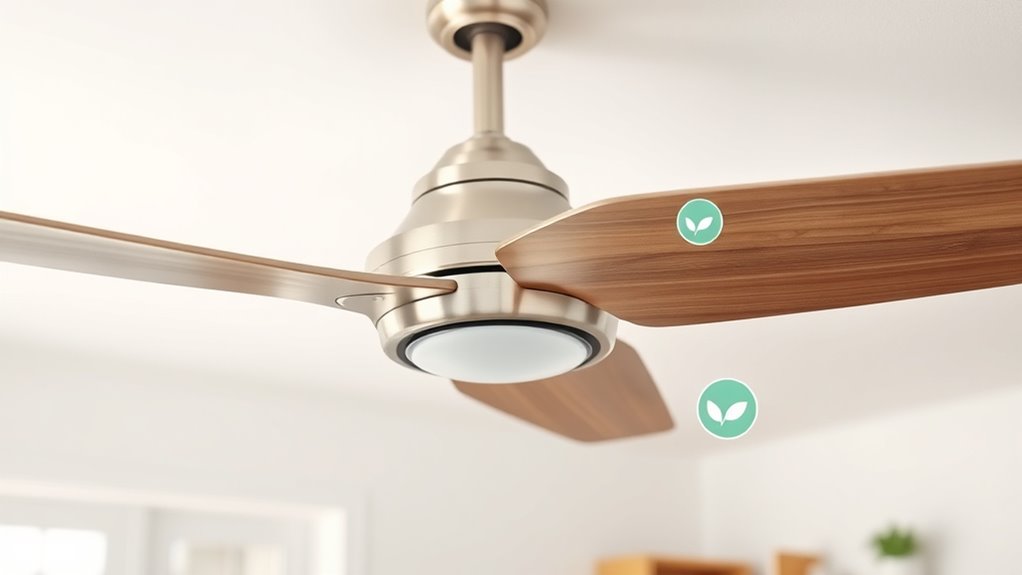To eliminate ceiling fan odors and musty smells, start by turning off power and carefully cleaning the blades with a microfiber cloth and a mild soap solution, adding vinegar or disinfectant for microbial buildup. Inspect and vacuum motor components, ensuring all dust and grease are removed. Regular maintenance, improved ventilation, and dehumidifiers help prevent recurrence. Understanding the causes and proper techniques will give you effective, long-lasting results—details that could transform your approach further.
Key Takeaways
- Turn off the fan, remove blades if possible, and thoroughly clean with a mild soap solution or vinegar to remove dust and microbial buildup.
- Inspect and clean motor housing and vents using compressed air or a vacuum with a brush attachment to eliminate dust and debris.
- Apply a suitable disinfectant or microbial spray to prevent mold growth, and dry all parts thoroughly before reassembling.
- Reduce humidity with dehumidifiers and improve ventilation; use air purifiers with HEPA filters to minimize airborne microbes causing odors.
- Schedule regular maintenance every 3-6 months, incorporating cleaning routines and environmental controls to prevent musty smells long-term.

Ceiling fan odors can accumulate over time due to dust, grease, and microbial growth, resulting in unpleasant musty or stale scents. These odors develop because dust particles settle on fan blades and motor components, providing a substrate for microbial colonization, especially in areas with high humidity. Additionally, airborne pollutants and residual grease from kitchen environments can adhere to surfaces, further intensifying odors. As the fan operates, disturbed particles are dispersed into the air, creating a pervasive smell. Identifying the specific cause of odors requires inspecting the fan’s components, including blades, motor housing, and mounting brackets, for visible buildup or contamination.
Cleaning is the most effective method to eliminate ceiling fan odors. You should start by turning off the power supply and carefully removing the fan blades, if possible. Use a microfiber cloth or a soft brush to remove loose dust and debris from all accessible surfaces. For more persistent grime, prepare a cleaning solution with mild soap and warm water, ensuring the solution is free of harsh chemicals that could damage finishes. Dampen a cloth with this solution and wipe each blade thoroughly, paying attention to edges and corners where dust accumulates. For grease or microbial buildup, incorporate a mild disinfectant or a solution containing vinegar, which has antimicrobial properties. Avoid soaking the blades to prevent warping or damage to the motor or electrical components.
Turn off the fan, carefully remove blades, and clean with a soft cloth and mild soap to eliminate odors effectively.
In addition to cleaning the blades, inspect the motor housing and any vents for dust or microbial presence. Use compressed air or a vacuum with a brush attachment to dislodge dust from vents and motor casings. If microbial growth is suspected, consider applying a disinfectant spray specifically designed for electronic and mechanical components, following manufacturer guidelines. Dry all parts thoroughly before reassembling to prevent moisture from promoting further microbial growth or corrosion. Regular maintenance intervals—every three to six months—are recommended to prevent odor buildup, especially in humid environments. Using a damp cloth with vinegar or specialized fan cleaner can be incorporated into routine cleaning schedules. Incorporating air purifiers with HEPA filters can further help reduce airborne microbes that contribute to odors.
To further mitigate odors, consider installing a dehumidifier or improving ventilation in the room, as high humidity promotes microbial growth. Air purifiers equipped with HEPA filters can also trap airborne particles and microbes, reducing sources of foul odors. If odors persist despite cleaning, examine the fan’s mounting and surrounding areas for mold or mildew, which may require professional remediation. Consistent, thorough cleaning combined with environmental control measures notably reduces the likelihood of musty or stale scents emanating from ceiling fans, ensuring a healthier indoor atmosphere and prolonging the lifespan of the fixture.
Frequently Asked Questions
How Often Should I Clean My Ceiling Fan to Prevent Odors?
You should clean your ceiling fan every two to four weeks to prevent odors. Regular cleaning removes dust, dirt, and allergens that can contribute to musty smells. Turn off the fan and use a microfiber cloth or duster to wipe down blades and motor housing. For stubborn grime, dampen the cloth with a mild cleaning solution. Consistent cleaning maintains ideal airflow and minimizes odor buildup, ensuring a fresh environment.
Can Replacing the Fan’s Filters Eliminate Musty Smells?
Replacing your ceiling fan’s filters can reduce musty smells if the filters are designed to trap dust, mold spores, or airborne contaminants. However, most ceiling fans do not have filters, so odor elimination depends on cleaning blades, motor components, and surrounding areas. Regular maintenance, including thorough cleaning and ensuring proper ventilation, is essential for effectively controlling musty odors rather than relying solely on filter replacement.
Are There Natural Remedies to Eliminate Ceiling Fan Odors?
Yes, you can use natural remedies to eliminate ceiling fan odors. You should regularly dust and clean the blades with a mixture of white vinegar and water to neutralize odors. Placing activated charcoal or baking soda nearby absorbs lingering smells. Additionally, lemon essential oil on a cloth wiped over the blades provides a fresh scent. These methods are effective, cost-efficient, and reduce chemical exposure, maintaining a cleaner, odor-free environment.
How Do Humidity Levels Affect Ceiling Fan Odor Buildup?
Humidity levels markedly influence ceiling fan odor buildup, as high humidity fosters mold and mildew growth, which can increase musty smells by up to 80%. When humidity exceeds 60%, moisture accumulates on fan blades and internal components, promoting bacterial and fungal growth. Maintaining indoor humidity between 30-50% helps prevent these issues, reducing odor formation and ensuring your ceiling fan remains fresh and free of musty smells.
Is It Safe to Use Chemical Cleaners on Ceiling Fan Blades?
Yes, it’s generally safe to use chemical cleaners on ceiling fan blades, but you should choose gentle, non-abrasive options like diluted dish soap or a mild all-purpose cleaner. Always turn off the fan and disconnect it from power before cleaning. Spray cleaner onto a soft cloth rather than directly on blades to prevent liquid from reaching motor components, which could cause damage or electrical issues.
Conclusion
By thoroughly cleaning your ceiling fan blades and ensuring proper ventilation, you effectively eliminate persistent odors and musty smells. Picture fresh air circulating smoothly, replacing stale, damp odors with crisp, clean scents. Regular maintenance prevents odor buildup, maintaining ideal air quality. Implement these precise steps consistently to keep your ceiling fan smelling fresh, ensuring a healthier, more comfortable living space. Proper care transforms your fan from a source of scents into a symbol of clean, crisp air.









